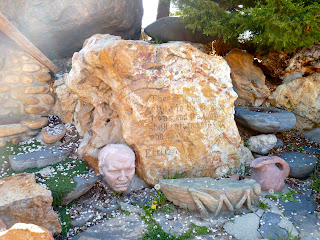The history of the Garden on Wikipedia reads: "Thomas Child, a masonry contractor and Bishop of the 10th Salt Lake LDS ward, conceived of a symbolic sculpture garden that would be a retreat from the world and a tribute to his most cherished religious and personal beliefs. He began building the garden in the back yard of his family home in 1947, when he was 57 years old, and continued to pour his time and money into the work until his death in 1963. Child named the garden Gilgal after the Biblical location where Joshua ordered the Israelistes to place twelve stones as a memorial. The name 'Gilgal' is sometimes translate to mean 'circle of standing stones,' an appropriate appellation for a sculpture garden. Gilgal is also the name of a city and a valley in The Book of Mormon, a sacred scripture in Mormonism.
"Many of the sculptures and quotations found at Gilgal refer to LDS themes: the restoration of the Priesthood, the great Mormon migration west, and the many similarities Child saw between the ancient Israelists and his LDS forefathers.
"Although Child was not a classically trained artist, he went to great lengths to obtain and shape the perfect stones for his beloved garden. He created a complete workshop in his yard for handling and cutting the stones, proudly stating that all the finish work for his statues was completed on the site.
"The finished statues are likewise unconventional, even eccentric: a sacrificial altar, a shrine to Child's beloved wife Bertha, even a sphinx with the face of Mormon prophet Joseph Smith, Jr. Child, who shared the garden with thousands of visitors over his lifetime, knew that not everyone would appreciate his particular vision. His primary concern, however, was the the garden would succeed in marking people think: 'You don't have to agree with me,' he said. 'You may think I am a nut, but I hope I have aroused your thinking and curiosity.'
"Until 2000, the Garden was owned by the late Grant Fetzer family. Fetzer was a neighbor who bought the property after Child's death in 1963. Only open on Sundays, the garden was visited and often vandalized by late night trespassers. The family, tired of keeping up the garden considered making it the centerpiece of an apartment development. Later a plan was floated by a Canadian company to teach down the garden and put in condominiums.
"Instead, a group of citizens called the Friends of Gilgal Garden, headed by Hortense Child Smith, the widow of Child's son, purchased an option to buy the property provided they could raise funds by January 10, 2000. The group arranged a $400,000 commitment from Salt Lake County and $100,000 each from The Church of Jesus Christ of Latter-day Saints and the George S. and Dolores Dore Eccles Foundation, covering the lion's share of the purchase price. However these commitments were conditioned on the garden becoming a city park, which Salt Lake City Council was reluctant to take because of a budget crunch. The property was eventually purchased for $679,000 and turned over to the city. On October 21, 2000, Gilgal Garden reopened as a city park. At a ceremony celebrating the occasion, Salt Lake City Mayor Rocky Anderson called the Garden 'an absolute jewel.'"
Gilgal Garden, the only visionary art environment in Utah, is located at 749 E 500 S in Salt Lake City. It is sandwiched between two houses and is incredibly easy to miss if you don't know its there. In fact, I have talked with several locals that did not even know that it exists. The Garden is open from 8 AM to 8 PM from April to September and from 9 AM to 5 PM from October to March.
My favorite art piece at the Garden is one of Child himself. Child created a statue of himself with brick pants. He pieced all the bricks together before firing to make sure the statue would look correct, he disassembled the bricks, and numbered each one. However, during the firing, the numbers ran off. Child had to reassemble the brick pants much like a jig-saw puzzle in order to put the statue back together.
Below are several pictures of the Garden. Immediately below is the location of the garden, between the two houses on the north side of the road. As I said earlier, it can be easy to pass by.
Similar to Hobbitville, there are several stones throughout the Garden with sayings carved into them. Most of the sayings are scriptures from the Mormon Canon (the Bible, the Book of Mormon, the Doctrine and Covenants, and the Pearl of Great Price)
Photo courtesy of visitusa.com
The piece below is a representation of a sacrificial altar.
The famous brick pants.
Courtesty of bestroadtripever.com
An archway with a very large keystone and four books representing the Mormon canon.
At the Gardens are a couple of really cool bird houses.
Gilgal's wife. Yes, it does look as spooky in real life.
A representation of Daniel 2
Gilgal Garden is one of my favorite place in Salt Lake, simply because of it one-of-a-kind quirkiness. It is a beautiful area and a fun place to visit. If you would like more information about the Gilgal Garden or would like to make a tax deductible donation, please visit the Friends of the Gilgal Garden website.
While researching Gilgal Gardens, I came across some really cool artwork by Ryan Perkins. I wanted to include his piece entitled "The Man Child (in Gilgal)" which is an image of the statue of Child wearing the brick pants.
Courtesy of ryanperkins.net
LOST IN HISTORY: Thomas Child was the bishop of the ward that met at the 10th Ward Meeting House. This building still stands. Where in Salt Lake is it located? As an additional help, there is an image of the building behind the statue of Child wearing the brick pants.




























